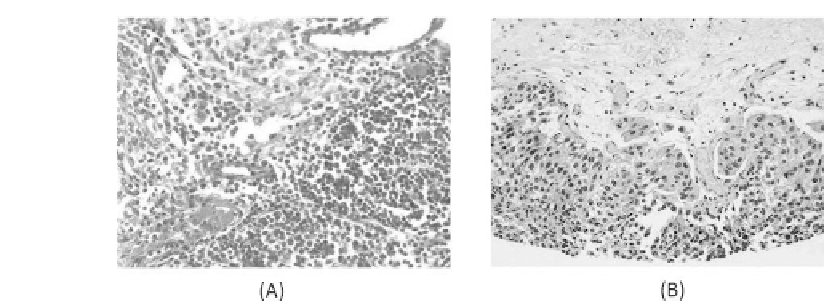Biomedical Engineering Reference
In-Depth Information
FIGURE 8.1: A high-power photomicrographs showing microinvasive solid
tumors. (A) Single aggressive malignant cells of a type B2 thymoma detaching
from the main malignant mass, located in the anterior mediastinum and myas-
thenia gravis. (B) pT1 urothelial carcinoma invading into the lamina propria.
In both cases, it is possible to notice single isolated cells or irregular small
clusters of cells invading the surrounding tissue. Image (A) courtesy of the
Institute for Cancer Research and Treatment of Candiolo (I.R.C.C.), image
(B) taken from
www.visualhistology.com.
dynamics of the invasive phase of tumor development, in particular of the
morphological instability resulting in the shed of aggressive single cells, rep-
resents therefore a fundamental issue in cancer research, as also commented
in [94].
In the last decades some help has been provided by computational ap-
proaches, able to realistically reproduce selected features of the biological sys-
tem and to test potential anti-tumoral strategies, as pointed out by the topics
[57, 240] and by the excellent reviews [15, 30, 59, 179, 239, 241, 321, 317, 392].
The variety of numerical methods now available for performing simulations of
nonlinear solid tumor growth and invasion has been typically based on either
continuous or discrete approaches. Among continuous techniques, single-phase
models deal with tumor front invasion and surface growth, as reviewed in
[48, 74, 239, 392], while multiphase mixtures present tumor interface instabil-
ities, see [15, 245, 318]. However, all these approaches overlook the behavior
and the mutual interactions of single cells, which, as seen, are fundamental in
determining the invasiveness of cancers and the subsequent metastatization.
Discrete techniques, which include cellular automata and agent-based models
[5, 12, 202, 235, 262, 326, 395], are instead able to preserve the identity of each
simulated individual, to capture more naturally their biophysical properties,
such as shape change, adhesion and intrinsic motility, and to handle local dy-
namics. On the contrary, as already commented in the Preface of the topic,
purely discrete models translate complex microscopic processes into simple
phenomenological rules, are dicult to study analytically and the associated







Search WWH ::

Custom Search